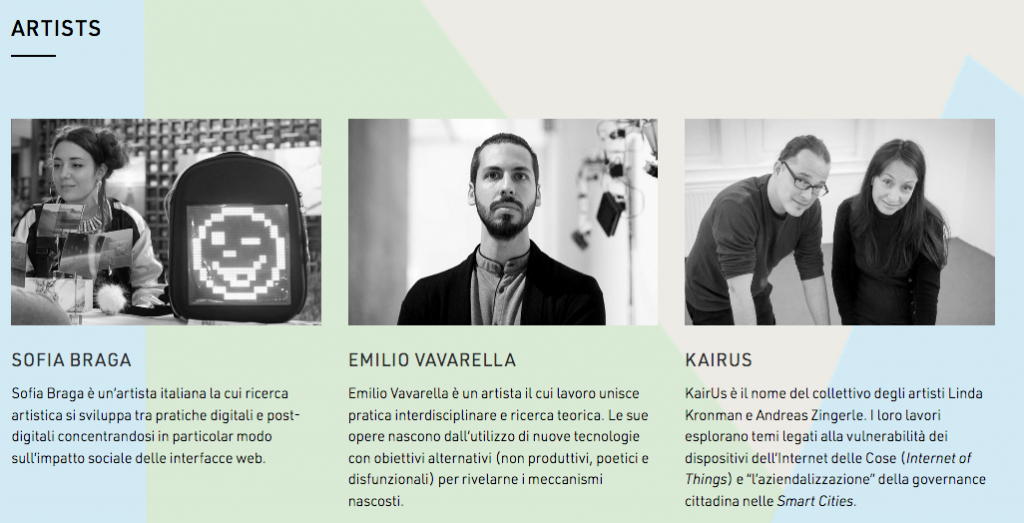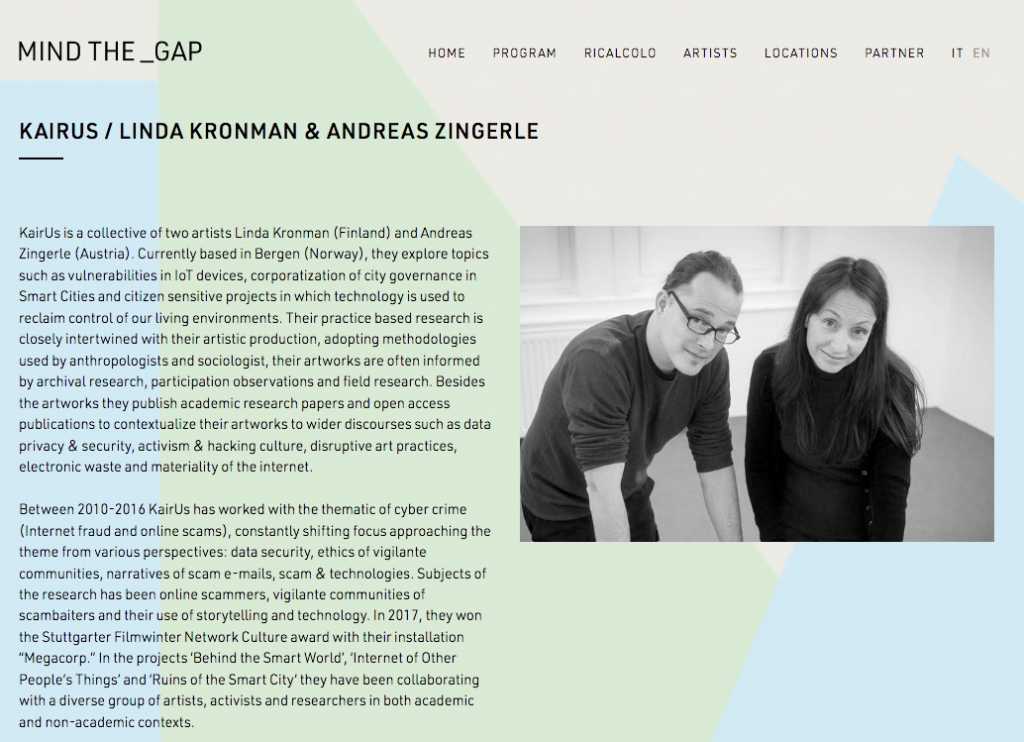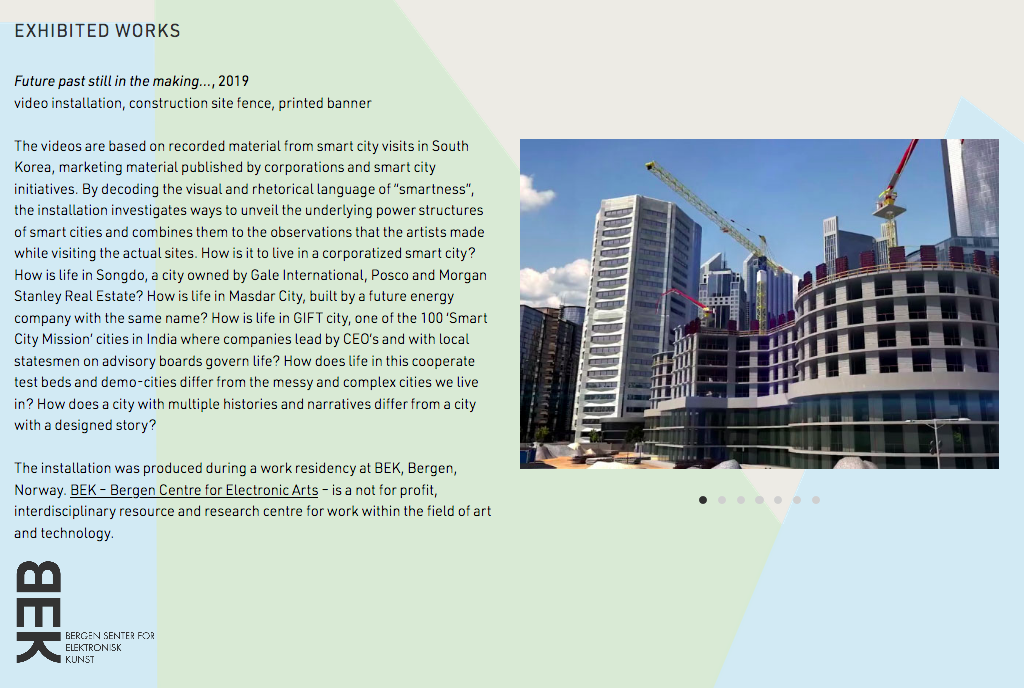RICALCOLO – RECALCULATE
Gorizia, 12 gennaio – 9 febbraio 2020
KB 1909
Biblioteca Statale Isontina
Parco Basaglia – Dipartimento di Salute Mentale
Recalculating
Computing territories and their analog actuators
The third edition of Mind the Gap, entitled Recalculating. Computing territories and their analog actuators, is part of a project of contemporary art, conceived in collaboration with Parco Basaglia, in Gorizia. it consists of a collective exhibition on the topics of technological infrastructures, of people’s relationship with technology, of the virtual representation of physical landscapes and of ideal models of cities of the future: all these topics are investigated and deconstructed through the works of artists Sofia Braga, Emilio Vavarella and of KairUs, a collective of two artists, Linda Kronman and Andreas Zingerle.
The project originates from the assumption that in the present digital time, it has become natural to consider virtual and physical spaces as deeply intertwined. If up until a few years ago, before the boom of smartphones and online platforms, these terms used to constitute opposed concepts, they are now complementary aspects of the same definition of reality. As a matter of fact, products, tools, services or events originating online have absolutely real consequences in the physical world: one needs only to consider the numerous apps for smartphones allowing users to control and switch on light bulbs or heating systems from any location, or the various Intelligent Virtual Assistants which can autonomously buy groceries by means of a simple vocal order. There is no need to go into the details of technology to affirm that in the past ten years our daily imagery – especially in the industrialised Western countries – has been populated by non-human and immaterial agents which have progressively started to autonomously perform actions which one would have never imagined could be delegated to a machine. Actions which, on the other hand, did not even previously require the Internet to work – take again the example of apps to control lamps. It is a collective imagery often built upon visual or linguistic metaphors, which usually appear as fluid, magical, intuitive and experiential, often referring to a system of very much stylised imagery deriving from a not well-defined natural world. For example, water, fire, and air respectively become the Cloud, the firewall, the Airdrop, whose function is to mediate and facilitate our relationship with the world. However, at the same time, interfaces also tend to hide from our sight the effective functioning of the machinery which allows the whole infrastructure to connect with the physical dimension of reality: something often much less “smart” than what we usually get to see.
The exhibition Recalculating. Computing territories and their analog actuators originates from these premises and extends them to the observation of how the encounter between digital and physical dimensions takes place tangibly at the interaction between these two aspects of reality. It is the few square centimetres of the sensors and electromechanical actuators, and the screens of the devices, that make this interchange possible as well as the transformation of an analog impulse into a digital one and vice versa.
Here, the high res surface collides with low tech reality. As it has often been expressed in the world of digital activism, contrary to how they are usually described, these technologies are in fact never neutral. Sensors transform the complexity of reality into a string of numbers and are the first responsible for its quantization and interpretation, while interfaces influence the impression of veracity of its representation. When an interface is not friendly or intuitive enough, the user might tend to consider its underlying processes as equally non-reliable. On the contrary – and this is exactly what the exhibition aims to highlight – the whole digital product or service will automatically benefit from the interface when it appears trustworthy. As a matter of fact, many apps prove quite successful from a commercial point of view thanks to the marketing and the User Experience Design employed in the creation of the product, rather than their effective technical superiority when compared to competing projects.
Sharing some skepticism towards the perfection of technology, the works by Sofia Braga, Emilio Vavarella and KairUs unveil what happens immediately beneath the shiny interfaces of contemporary technologies. The artists use tools and techniques drawn from different fields of aesthetic and social research, from technological activism to the documentary and archival practice of the digital materials available online. With their works, they highlight the aesthetics, the rhetoric and the contradictions existing between the smart and the dumb worlds, trying to unmount and critically face the illusions and the false hopes of contemporary technology: digital perfection, the attraction of the screen and the Beckettian enthusiasm for a better – magnificent and technological – future which will probably never be achieved, but whose virtuality alone is enough to empower digital marketing and internet additction.
Sofia Braga’s work originates in the context of social networks, where any form of personal contribution becomes a valuable material for the community or for the company controlling it. Every post, swipe, share or like is an essential part of an algorithmic structure based on engagement – the ability to create an emotional link between the user and the platform – focusing the user’s attention on interaction itself, thus creating a self-referential cycle which rejects everything which is not essentially part of it. In this cycle, the user and its personal data are respectively the engine and the battery of the platform: data are collected through an actual procedure of extraction based on interaction, whose vortex of digital prompts only slows down when the battery of one’s device runs low. In this situation, in fact, the dynamics of the economy of attention and our addiction become manifest, almost offering an opportunity to actually subvert its functioning. What can be done about it? The answer of the artist is ironic: one only needs to sit back, relax and keep scrolling, waiting for the smartphone’s battery to recharge, all nested among the sweet waves of the “infinite feed”.
A collaborative work typical of digital communities is at the core of Emilio Vavarella’s work on Google Street View, a popular map service consisting of a platform which incessantly transforms billions of new panoramic images taken by voluntary collaborators into a virtual representation of the Earth’s surface. Through a process of exploration of the digital service, Vavarella collected its glitches – the digital errors deriving from the algorithms used to create the virtual map – resulting in an ever-growing archive. On the inside, there are not only distorted or poorly-generated representations, but also images revealing elements usually hidden to the end-user, such as the actual technologies employed in the production of the map or the identity of the anonymous cartographers. Besides bearing witness to the inaccuracy of the system and of its construction, the archive focuses on the processes of re-writing in action on the platform itself. In Street View, the detected glitches are constantly being corrected and hidden thanks to the voluntary help of users themselves, once again engaged in the process of the constant perfecting of a digital apparatus which often bluffs its own effective perfection.
The collective KairUs, formed by Linda Kronman and Andreas Zingerle, works on the difference between the rhetoric of marketing and the effective construction and production of the smart world. In their works, KairUs deconstructs the enthusiastic language of corporate communication in order to unveil, for example, how the common systems of digital video surveillance – promoted as a technology aimed at the security of individuals – can be used in a completely different way, potentially disclosing to anyone the video materials recorded in private environments. In a recent research, the duo shows how urban planning of smart cities of the future is basically based on the rhetorical and ideological expedients of great digital corporations, which contribute to and draw from the collective imagery of the smart life to develop and sell their projects of futuristic business. These projects share the vision of building a smart city which does not need humans for the effective management of the urban infrastructure. Despite these pretentious premises, these great experiments of “corporatized” cities, that is to say, produced and managed by corporations, usually prove to be failures as soon as they are created, especially due to the frequent malfunctions of an infrastructure designed to last much longer. All of this quickly brings us back to the paradox according to which technology needs human workers once again in order to complete tasks which should have ideally been carried out by machines, but that would eventually be too expensive, or not efficient enough to use.
This is probably the most interesting contradiction of contemporary technologies: they appear as being so perfect as to be “autonomous”, never having to face human imperfection. At the same time, in order to function, they actually need human intervention to hold the smart illusion of efficiency and perfection together. Such a bipolar attitude is hidden in the smart – perfect and infallible, almost alien – interfaces, regulating the interaction between the digital and the physical worlds and which, at the same time, hide their own limits through strategies of visual suggestions, rhetoric and marketing. The truth is that continuous work is needed backstage in order to fix the holes and the imprecisions between the physical background and the digital surface, a fundamental and equally invisible role within the platforms. This is more than often analog and “repetitive” work, where data and reality are being realigned and balanced by invisible and anonymous contributions.
Through the works on display, the exhibition focuses on the extractive nature of contemporary technology and, more generally, on the pervasive rhetoric of smart life, that is to say, the tendency to build machines whose functioning is based on the exploitation of material or immaterial resources for the economic benefit of the few and the rhetorical dynamics built to convince us to concede to the growing apparatus of digital surveillance in exchange for the comfortable benefits of wireless agency. What is put on display here is the vision of a world not only made of perfect and infallible technologies, but also of their reality made of 404, planning errors and of great digital projects crumbling under the simple complexity of analog, physical reality. Accepting such dualism and imperfectability, perhaps, could be a first step towards a re-balancing of the relationship between man, environment and technology, towards economic and technical systems which are more tolerant towards Earth’s resources and all its citizens.

Sofia Braga (Parma, 1991) is an italian artist based in Linz (AT). She develops her artistic research at the intersection between Digital and Post-Digital practices, focusing especially on the materiality of the web and the social impact of web interfaces. She graduates in Visual Arts (BA, MA) at the Academy of Fine Arts of Bologna and is currently attending the Interface Cultures master program at the University of Art and Design of Linz. In 2019 she was artist in residence at IAMAS – Institute of Advanced Media Arts and Sciences in Ōgaki, Japan and she curated the Internet Yami-Ichi at Ars Electronica Festival and its first Italian edition in Bologna.
Her works have been exhibited at Ars Electronica Festival (Linz, AT), The Wrong – The New Digital Art Biennale, Pinacoteca Albertina di Torino (IT), Deutsche Bank (Milan, IT), Xie Zilong Photography Museum (Changsha, CN), XII Video Vortex Conference (La Valletta, MT), Speculum Artium (Trbovlje, SI), Link Cabinet (IT) and more.
Emilio Vavarella is an artist whose work blends interdisciplinary art practice and theoretical research and is centered around the study of the relationship between humans and technological power. His works present a combination of using new technologies with alternative (non-productive, poetic, dysfunctional) goals in mind, imagining technology’s future effects through the use of speculative fiction, and decontextualizing and misusing technology to reveal its hidden mechanisms.
Emilio is currently working toward a PhD in Film and Visual Studies and Critical Media Practice at Harvard University. Venues that have exhibited Emilio’s work include: MAXXI – Museo nazionale delle arti del XXI secolo; KANAL – Centre Pompidou; MAMbo – Museo d’Arte Moderna di Bologna; Villa Manin; Museo Nacional Bellas Artes in Santiago; National Art Center of Tokyo; Eyebeam Art and Technology Center; Fondazione Studio Marangoni and Fondazione Bevilacqua La Masa.
KairUs is a collective of two artists Linda Kronman (Finland) and Andreas Zingerle (Austria). Currently based in Bergen (Norway), they explore topics such as vulnerabilities in IoT devices, corporatization of city governance in Smart Cities and citizen sensitive projects in which technology is used to reclaim control of our living environments. Their practice based research is closely intertwined with their artistic production, adopting methodologies used by anthropologists and sociologist, their artworks are often informed by archival research, participation observations and field research. Besides the artworks they publish academic research papers and open access publications to contextualize their artworks to wider discourses such as data privacy & security, activism & hacking culture, disruptive art practices, electronic waste and materiality of the internet.
Between 2010-2016 KairUs has worked with the thematic of cyber crime (Internet fraud and online scams), constantly shifting focus approaching the theme from various perspectives: data security, ethics of vigilante communities, narratives of scam e-mails, scam & technologies. Subjects of the research has been online scammers, vigilante communities of scambaiters and their use of storytelling and technology. In 2017, they won the Stuttgarter Filmwinter Network Culture award with their installation “Megacorp.” In the projects ‘Behind the Smart World’, ‘Internet of Other People’s Things’ and ‘Ruins of the Smart City’ they have been collaborating with a diverse group of artists, activists and researchers in both academic and non-academic contexts.



About Mind the gap:
Mind the Gap is a project on visual contemporary arts organised by Altreforme in Gorizia, in collaboration with different cultural institutions and institutional agents of the city. The project, started in 2017, takes place inside Parco Basaglia and in various places of the city.
Mind the Gap perfectly fits the purposes and the spirit of Parco Basaglia, the place where in 1961 the eponymous Italian psychiatrist started his own therapeutic and social revolution. Moreover, it also aims at reinforcing participatory cultural processes over the years and through multiple actions. As Franco Basaglia once affirmed, art and culture can become devices to engage both the places and their system of relations.
